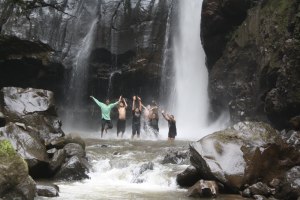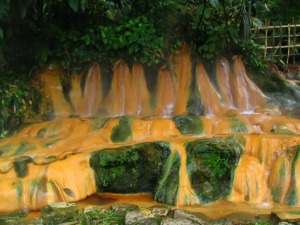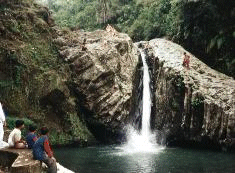
In the northern region of Yogyakarta, about 12 miles from downtown, there is a temple which ndak many people may know. Although located in a densely populated area, the existence of this temple as if it was still excluded.
Gebang temple, the temple is sometimes a tiny patterned oldest Hindu temple in Yogyakarta, even older than the estimated Kalasan, the oldest Buddhist temple in Yogyakarta that.
Go to here, as if to give the impression of contrast. The temple is located in the village of Gebang, Village Wedomartani, District Ngemplak, Sleman, which is a dense residential area of this condition was quite apprehensive.
Follow signs to the temple which started obsolete makes us as if to ask, what yes temple is situated between residential housing? Sure enough, this temple was apparently located at the “edge” is a residential area.
Located in the middle of rice fields, the road leading to the temple is also arguably a dirt path. Ah, but I’ve walked the temple which is located more pathetic, really. : D
Amazing! Although its location is “remote”, but the condition of the temple complex is very well maintained. with a barbed wire fence surrounds, further strengthen the impression of the remote.
When I arrived in the afternoon, the entrance gate is locked. At the checkpoint, ndak anyone could I meet.
I saw a ditch soil contained a small hole under the barbed wire strands. Mind-style thief I work, I was desperate to break into the ditch before! >:)
Ah, the feeling of amaze when I saw the building of the temple re-pervasive spirit. A feeling that I do not find anywhere else, except in the temple of course. Especially with this kind of situation quiet, makes me more freedom to enjoy and admire its beauty. Ah, truly soothe the soul!
This temple ndak large, measuring approximately 5.25 x 5.25 meters with a height of 7.75 meters, is located right in the middle of the page that a lot of breadfruit trees and acacia.
Ndak lot of background information regarding the construction of the temple were found in November 1936 this. Even the king who built and what the meaning is still mystery.
Starting from the discovery of a statue of Ganesha by residents, who, after apparently traced statue is part of the temple. no inscriptions found that the age of the temple can only be estimated from the pattern and the physical form of the temple.
The temple is very pathetic condition when found, namely in the form of collapsed buildings. The restoration is then carried back to the temple in 1937 and completed in 1939 under the leadership of the Dutch scientist, Prof.. Dr. Ir. Van Romondt.
Physical characteristics of the building showed that adopt the Hindu temple, with the discovery of the statue of Ganesha, Yoni and Linga.
The whole body of this temple is very plain, with no relief carving, unlike other Hindu temples. If anything, his impression is still very simple. From this thought, this temple was built at the beginning of the 7th century, around the year 730 to 800 AD
This temple is facing east, with a room containing Yoni with the spout facing north without the linga. At the top of the entrance, there is a sort of canopy with a simple decoration Kala.
Uniquely, I do not find a ladder to get into this room is usually decorated with Makara.
On either side of the entrance, only found Nadiswara statue on the right, while the Mahakala statue on the left ndak found.
The temple walls north and south is found only empty niches, whereas in the western part there is a statue Ganesha who is in a Yoni with the spout facing north.
Ganesha statue on top of Yoni
Judging from the characteristics during the Hindu temple, as can be seen in the temple Sambisari and the third temple on the Temple complex Gedong Songo, niches in the north should be filled by a statue of Agastya and the south is the statue of Goddess Durga.
Foot high terrace of the temple without any relief carvings also show old age of the temple.
Looking to the roof, I was surprised. There’s something different when compared to other Hindu temples. The roof consists of 3 levels is quite unique and interesting.
At the first level, there is a niche with relief of a human head on each side. From the shape of human head cover, estimated at a picture of Hindu priests.
This is reinforced by an alcove decorated with Kala-Makara on the roof of the second level of this form of human figure sitting cross-legged.
Decorations on the roof of the temple
At the top, roof-shaped ndak Ratna or Stupa, but it is a cylindrical Linga which is above the Seroja.
When I trace, apparently when the Linga on the roof is drawn a straight line, its position right in the middle of the Yoni that is in the temple. This is reinforced by the recesses on the roof next to the temple.
Linga garnish on top of this Seroja also exist at each level of the roof. In addition, the ornament of Antefix can be found on the upper level.
Carvings and statues of Hindu priests, it could be this temple is often used by priests to calm down and imprisoned. This is supported with a cozy atmosphere, cool, and beautiful because there are around the trees that shade. I even found some tail butterflies flying around the temple is like to give the impression of peace.
Temple complex Gebang
Visit to this temple complex could be an alternative tourism and education. The atmosphere is beautiful and calming down in the mouth can be a drug, like what I felt yesterday.
Since the days begin to grow dusk, I was forced to end my visit to this temple. Ah, looks like I’ll miss this place again ..
 Ketep Pass near attractions, natural attractions there are no less thrill. His name Kedung Kayang Waterfall, unfortunately the presence of these attractions are still a few people who know because they have not managed optimally.
Ketep Pass near attractions, natural attractions there are no less thrill. His name Kedung Kayang Waterfall, unfortunately the presence of these attractions are still a few people who know because they have not managed optimally.









